
S25 Streptomycin
RM0.00Brand:
Thermo ScientificTM OxoidTM

S3 300 Compound Sulphonamide
RM0.00Brand:
Thermo ScientificTM OxoidTM

Sabouraud Dextrose Agar 500g, Oxoid
RM248.00Brand:
Thermo ScientificTM OxoidTM
Identify dermatophytes and other fungi and yeasts in clinical specimens and environmental samples with the acidic Thermo Scientific™ Oxoid™ Sabouraud Dextrose Agar. The low pH supports the growth of fungi while inhibiting bacterial growth in mixed samples. Fungi maintain their typical cultural appearance and, thus, may be readily identified according to standard macroscopic characters.
| Typical Formula * |
gm/litre
|
| Mycological Peptone |
10.0 |
| Glucose (dextrose) |
40.0 |
| Agar |
15.0 |
| pH 5.6 ± 0.2 @ 25°C |
Directions
Add 65g of Sabouraud Dextrose Agar to 1L of distilled water. Sterilize the medium by autoclaving at 121°C for 15 mins. Mix well and pour into a clean petri dish.
Storage Conditions and Shelf Life
Store the medium at 10-30°C and use before the expiry date printed on the label. Store the prepared medium at 2-8°C.
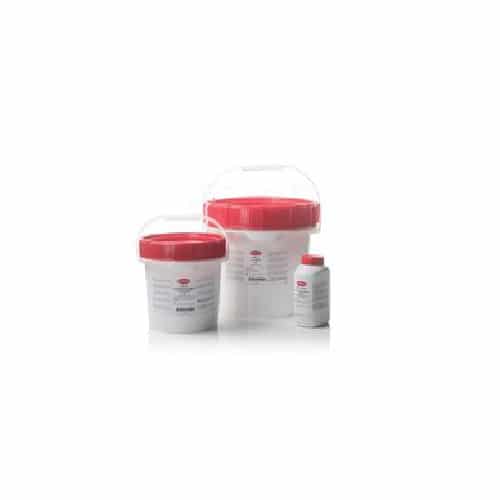
Sabouraud Dextrose Liquid Medium 500g
RM247.00Brand:
Thermo ScientificTM OxoidTM
Oxoid Sabouraud Liquid Medium is an USP formulation for mycological sterility testing.
Sabouraud Liquid Medium, Oxoid Composition
| Formula |
gm/litre |
| Dextrose |
20.0 |
| Pancreatic digest of casein |
5.0 |
| Peptic digest of animal tissue |
5.0 |
| pH 5.6 ± 0.2 @ 25°C |
Sabouraud Liquid Medium, Oxoid Preparation:
Dissolve 30g in 1 litre of water (purified as required). Mix well, distribute into final containers and sterilise by autoclaving at 121°C for 15 minutes.
Storage conditions and Shelf life
Store the dehydrated medium at 10-30°C and use before the expiry date on the label.
Store the prepared medium away from light between 2-25°C.

Sabouraud Maltose Agar 500g
RM972.00Brand:
Thermo ScientificTM OxoidTM
Oxoid Sabouraud Maltose Agar is used where maltose is the preferred carbohydrate source.
Sabouraud Maltose Agar, Oxoid Composition
| Typical Formula* |
gm/litre |
| Mycological peptone |
10.0 |
| Maltose |
40.0 |
| Agar |
15.0 |
| pH 5.6 ± 0.2 @ 25°C |
Sabouraud Maltose Agar, Oxoid Preparation:
Suspend 65g in 1 litre of distilled water. Bring to the boil to dissolve completely. Sterilise by autoclaving at 121°C for 15 minutes. Mix well and pour in to sterile Petri dishes.
Storage conditions and Shelf life
Store the dehydrated medium at 10-30°C and use before the expiry date on the label.
Store the prepared medium at 2-8°C.
Precautions
Some of the pathogenic fungi may produce infective spores which are are easily dispersed into the laboratory. Such organisms should be examined only within a protective cabinet.
The combination of cycloheximide and chloramphenicol inhibits many pathogenic fungi. However, the mycelial phase of Histoplasma capsulatum, Paracoccidioides brasiliensis, Sporothrix schoenckii and Blastomyces dermatitidis is not inhibited by these antibiotics when incubated at 25-30°C .
Note the precautions in handling cycloheximide described in HAZARDS section.
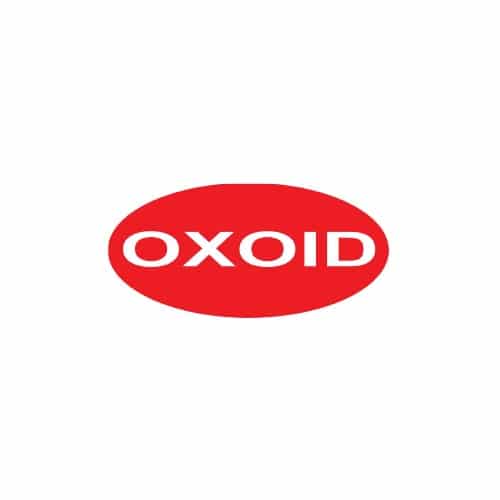
Saline Tablets, Oxoid
RM0.00Brand:
Thermo ScientificTM OxoidTM
This product is temporarily unavailable. Please contact us for more information.
Oxoid Saline Tablets is used for preparation of 500mL of 0.85% isotonic saline. For Laboratory Use Only.

Salmonella Rapid Test Medium 500g
RM0.00Brand:
Thermo ScientificTM OxoidTM
Oxoid Salmonella Rapid Test Elective Medium (SRTEM) is a selective enrichment broth medium specifically formulated for use with the Oxoid Salmonella Rapid Test Kit, Part No. FT0201A.
Salmonella Rapid Test Elective Medium (SRTEM), Oxoid Composition
| Typical Formula* |
gm/litre |
| Tryptone |
10.0 |
| Sodium chloride |
5.0 |
| Di-sodium hydrogen phosphate |
9.0 |
| Potassium dihydrogen phosphate |
1.5 |
| Casein |
5.0
|
| Malachite green |
0.0025
|
| pH 7.2 ± 0.2 @ 25°C |
Salmonella Rapid Test Elective Medium (SRTEM), Oxoid Preparation:
Add 61g to 1 litre of distilled water (double strength medium). Sterilize by autoclaving at 121°C for 15 minutes. Cool to 18-25°C and use as described in the Oxoid Salmonella Rapid Test (Code FT0201) instruction leaflet.
Storage conditions and Shelf life
Store the dehydrated medium at 10-30°C and use before the expiry date on the label.
Store the prepared medium at room temperature.
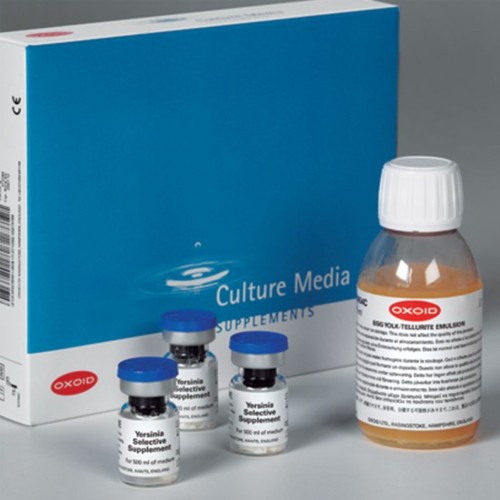
Salmonella Selective Supplement
RM486.00Brand:
Thermo ScientificTM OxoidTM
Oxoid Salmonella Selective Supplement is used for the presumptive identification of Salmonella species from clinical and food samples.
- Add to Chromogenic Salmonella Agar Base, Part No. CM1007B or Brilliance™ Salmonella Agar Base, Part No. CM1092B
- Each vial supplements 500mL of medium
Salmonella Selective Supplement, Oxoid Composition
| Vial Contents (each vial is sufficient for 500ml of medium) | per vial | per litre |
| Novobiocin |
2.5mg |
5mg |
| Cefsulodin |
6mg |
12mg |
Chromogenic Salmonella Agar, Oxoid Preparation:
Suspend 25g in 500ml of distilled water and add the contents of one vial of Salmonella Selective Supplement (SR0194) reconstituted as directed. Mix well and bring to the boil with frequent agitation. DO NOT AUTOCLAVE. DO NOT HOLD AT BOILING TEMPERATURE. Cool to 50°C, mix well and pour into sterile Petri dishes.
Brilliance Salmonella Agar, Oxoid Preparation:
Suspend 27g of Brilliance Salmonella Agar Base in 500ml of distilled water. Add the contents of 1 vial of Salmonella Selective Supplement, resuspended as directed. Mix well and sterilise by bringing to the boil with frequent agitation. Cool to around 50ºC, mix well and pour into sterile Petri dishes.
NOTE: It is critical that the selective supplement is added prior to heating. When preparing volumes greater than 1 litre contact Oxoid Technical Support for directions.
Storage conditions and Shelf life
Salmonella Selective Supplement should be stored in the dark at 2-8ºC. When stored as directed, the un-opened products will remain stable until the expiry date printed on the packaging.

SALT MEAT BROTH TABLETS (100S)
RM0.00Brand:
Thermo ScientificTM OxoidTM
Enrich and isolate halophilic organisms, especially staphylococci, using Thermo Scientific™ Oxoid™ Salt Meat Broth Tablets. Salt Meat Broth Tablets are specially designed for the isolation of staphylococci from grossly contaminated specimens such as feces, particularly during the investigation of staphylococcal food poisoning. The medium is highly sensitive as it can detect even low numbers of staphylococci from samples having large proportions of heterogeneous microbial flora.1,2
- Quantity: 100 tablets/bottle
Salt Meat Broth Tablets, Oxoid Composition
| Typical Formula* |
gm/litre |
| Peptone |
10.0 |
| `Lab-Lemco’ powder |
10.0 |
| Neutral ox-heart tissue |
30.0 |
| Sodium chloride |
100.0 |
| pH 7.6 approx. @ 25°C |
Salt Meat Broth, Oxoid Preparation:
Add 2 tablets to 10ml of distilled water in an appropriately sized test tube and soak for 5 minutes. Sterilise by autoclaving at 121°C for 15 minutes.
Storage conditions and Shelf life
Store the dehydrated medium at 10-30°C and use before the expiry date on the label.
Store the prepared medium at room temperature.

Sam20 Ampicillin/Sulbactam
RM84.00Brand:
Thermo ScientificTM OxoidTM

Sam30 Ampicillin Sulbactam
RM0.00Brand:
Thermo ScientificTM OxoidTM
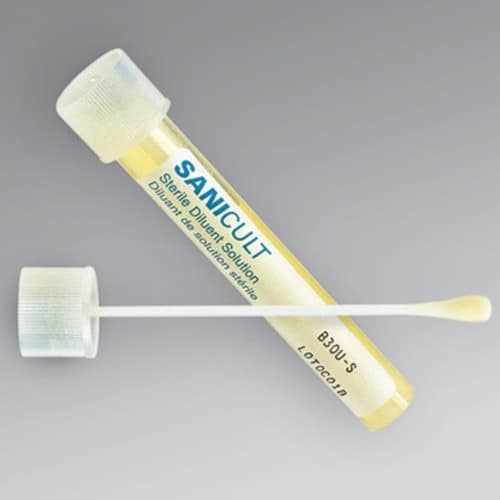
Sanicult (5ml) PK/100
RM0.00Brand:
Thermo Scientific™ Remel™
Thermo Scientific™ Remel Sanicult Environmental Transport Kits can be used to sample most surfaces or substances.
- Designed for hard-to-reach surfaces, viscous liquids, semi-solids, and powders
- Readily transported with room temperature storage
- Manufacturer: Starplex
Ordering Alerts:
Supplied one swab per envelope; 100 envelopes/pack.

SCF105 Sulbactam/Cefoperazone
RM0.00Brand:
Thermo ScientificTM OxoidTM

Schaedler Agar 500g
RM823.00Brand:
Thermo ScientificTM OxoidTM
Grow and isolate aerobic and anaerobic organisms of the intestinal tract, which may require selective conditions to inhibit the growth of background organisms like Escherichia coli, with Thermo Scientific™ Oxoid™ Schaedler Anaerobe Agar. The presence of cysteine in the medium provides selectivity against Escherichia coli as cysteine has shown to have inhibitory effects on several enzymatic reactions of Escherichia coli in vitro.1
Schaedler Anaerobe Agar, Oxoid Composition
| Typical Formula* |
gm/litre |
| Tryptone Soya Broth (Oxoid CM129) |
10.0 |
| Special peptone |
5.0 |
| Yeast extract |
5.0 |
| Glucose |
5.0 |
| Cysteine HCl |
0.4 |
| Haemin |
0.01 |
| Tris Buffer |
0.75 |
| Agar |
13.5 |
| pH 7.6 ± 0.2 @ 25°C |
|
Schaedler Anaerobe Agar, Oxoid Preparation:
Suspend 40g in 1 litre of distilled water and boil to dissolve the medium completely. Sterilise by autoclaving at 121°C for 15 minutes. Mix well before pouring.
Storage conditions and Shelf life
Store the dehydrated medium at 10-30°C and use before the expiry date on the label.
Prepared plates may be stored at 2-8°C if suitably protected.

Schaedler Broth 500g
RM386.00Brand:
Thermo ScientificTM OxoidTM
- Oxoid Schaedler Anaerobe Broth is a thioglycollate-free broth for the general growth of anaerobes.
- For use in blood cultures and antibiotic MIC studies.
Schaedler Anaerobe Broth, Oxoid Composition
| Typical Formula* |
gm/litre |
| Tryptone Soya Broth (Oxoid CM129) |
10.0 |
| Special peptone |
5.0 |
| Yeast extract |
5.0 |
| Glucose |
5.0 |
| Cysteine HCl |
0.4 |
| Haemin |
0.01 |
| Tris Buffer |
0.75 |
| pH 7.6 ± 0.2 @ 25°C |
Schaedler Anaerobe Broth, Oxoid Preparation:
Add 26.5g to 1 litre of distilled water and mix to dissolve completely. Dispense into final containers and sterilise by autoclaving at 121°C for 15 minutes.
Storage conditions and Shelf life
Store the dehydrated medium at 10-30°C and use before the expiry date on the label.
Store prepared broth in the dark at <15°C.
Precautions
As with all anaerobic broth media, it is important to avoid chemo-oxidation (overheating) and photo-oxidation (storage in the light) because such oxidative effects cause the inhibition of growth.

Sealing Clips For Anaerogen Compact
RM92.00Brand:
Thermo ScientificTM OxoidTM
Thermo Scientific™ Oxoid™ AnaeroGen™ Compact Sealing Clip is for use with AnaeroGen Compact Part No. AN0010C; Compact Plastic Pouch, Part No. AG0020C; AnaeroGen Compact Sachet, Part No. AN0020D; Thermo Scientific™ CampyGen™ Compact Sachet, Part No. CN0020C.
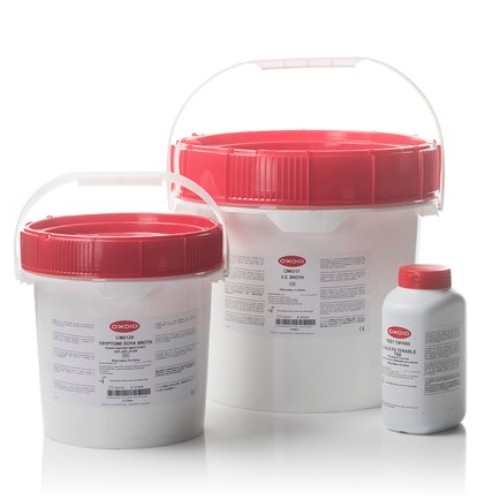
Selenite Broth Base 500g
RM283.00Brand:
Thermo ScientificTM OxoidTM
Enrich and isolate Salmonella from feces and food products with Thermo Scientific™ Oxoid™ Selenite Broth Base (Lactose).The presence of Selenium in the medium provides selectivity against non-target bacteria.
Selenite Broth Base (Lactose), Oxoid Composition
| Typical Formula* |
gm/litre |
| Peptone |
5.0 |
| Lactose |
4.0 |
| Sodium phosphate |
10.0 |
| pH 7.1 ± 0.2 @ 25°C |
Selenite Broth Base (Lactose), Oxoid Preparation:
Dissolve 4g of sodium biselenite LP0121 in 1 litre of distilled water and then add 19g of Selenite Broth Base. Warm to dissolve, mix well and fill out into containers. Sterilise in a boiling water bath, or in free flowing steam, for 10 minutes. DO NOT AUTOCLAVE.
To minimise any possible risk of teratogenicity to laboratory workers, the sodium biselenite must be added as a solution to this medium.
Robertson1 reported miscarriages and possible teratogenic effects on pregnant laboratory assistants which may have been caused by ingested sodium biselenite. Oxoid therefore removed this substance from the powdered medium.
Although no further reports have been received sodium biselenite is now considered to be very toxic and should be handled with great care.
Storage conditions and Shelf life
Store the dehydrated medium at 10-30°C and use before the expiry date on the label.
Store the prepared medium at 2-8°C away from light.
Precautions
Discard the prepared medium if large amounts of reduced selenite can be seen as a red precipitate in the bottom of the bottles.
Do not incubate longer than 24 hours because the inhibitory effect of selenite is reduced after 6-12 hours incubation.
Take sub-cultures of broth from the upper third of the broth column, which should be at least 5 cm in depth.
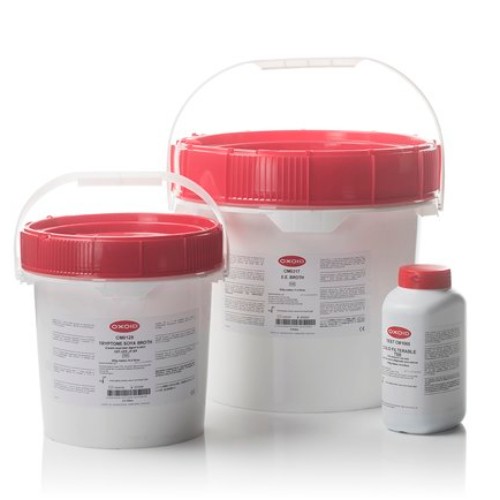
Selenite Cystine Broth Base 500g
RM414.00Brand:
Thermo ScientificTM OxoidTM
Enrich and improve the isolation of salmonellae from feces and food samples with Thermo Scientific™ Oxoid™ Selenite Cystine Broth Base. This modified medium is based upon the formulation described by Leifson with added cystine.
Selenite Cystine Broth Base, Oxoid Composition
| Typical Formula* |
gm/litre |
| Tryptone |
5.0 |
| Lactose |
4.0 |
| Disodium phosphate |
10.0 |
| L-Cystine |
0.01 |
| pH 7.0 ± 0.2 @ 25°C |
Selenite Cystine Broth, Oxoid Preparation:
Dissolve 4g of sodium biselenite LP0121 in 1 litre of distilled water and then add 19g of Selenite Cystine Broth Base. Warm to dissolve and dispense into containers. Sterilise by placing in free flowing steam for 15 minutes. DO NOT AUTOCLAVE.
Robertson reported miscarriages and possible tetragenic effects on pregnant laboratory workers which may have been caused by the ingestion of sodium biselenite. To minimise any possible risk of teratogenicity to laboratory workers the sodium biselenite is not included in the dry powder but should be prepared separately as a solution to which the Selenite Cystine Broth Base is added.
Storage conditions and Shelf life
Store the dehydrated medium at 10-30°C and use before the expiry date on the label.
Store the prepared medium at 2-8°C away from light.
Precautions
Observe the precautionary comments made about sodium biselenite in Selenite Broth Base CM0395.
Discard the prepared medium if large amounts of reduced selenite can be seen as a red precipitate in the bottom of the bottle.
Do not incubate longer than 24 hours because the inhibitory effect of selenite is reduced after 6-12 hours incubation.
Take subcultures of broth from the upper third of the broth column which should be at least 5 cm in depth.

Sensitest Agar 2.5kg
RM0.00Brand:
Thermo ScientificTM OxoidTM
This product has been discontinued. The alternative to this product is Sensitest Agar, 500g.
A medium specially designed to give large, clear zones with all antibiotics, without the addition of lysed or whole blood.
Sensitest Agar, Oxoid Composition
| Typical Formula* |
gm/litre |
| Hydrolysed casein |
11.0 |
| Peptones |
3.0 |
| Sodium chloride |
3.0 |
| Glucose |
2.0 |
| Starch |
1.0 |
| Buffer salts |
3.3 |
| Nucleoside bases |
0.02 |
| Thiamine |
0.00002 |
| Agar |
8.0 |
| pH 7.4 ± 0.2 @ 25°C |
Sensitest Agar, Oxoid Preparation:
Suspend 32g in 1 litre of distilled water and bring to the boil to dissolve the agar. Sterilise by autoclaving at 121°C for 15 minutes.
Storage conditions and Shelf life
Store the dehydrated medium at 10-30°C and use before the expiry date on the label.
Store the prepared plates of agar at 2-8°C.
Precautions
As with other susceptibility testing media, Sensitest Agar should be used for rapidly growing aerobic organisms only. It should not be modified by the addition of carbohydrates or incubated in a CO2 enriched atmosphere.
If the medium is used for Bell’s CDS method then the specified discs and technique must be used. Refer to the monograph cited in the References.

Sensitest Agar 500g
RM1,671.00Brand:
Thermo ScientificTM OxoidTM
A medium specially designed to give large, clear zones with all antibiotics, without the addition of lysed or whole blood.
Sensitest Agar, Oxoid Composition
| Typical Formula* |
gm/litre |
| Hydrolysed casein |
11.0 |
| Peptones |
3.0 |
| Sodium chloride |
3.0 |
| Glucose |
2.0 |
| Starch |
1.0 |
| Buffer salts |
3.3 |
| Nucleoside bases |
0.02 |
| Thiamine |
0.00002 |
| Agar |
8.0 |
| pH 7.4 ± 0.2 @ 25°C |
Sensitest Agar, Oxoid Preparation:
Suspend 32g in 1 litre of distilled water and bring to the boil to dissolve the agar. Sterilise by autoclaving at 121°C for 15 minutes.
Storage conditions and Shelf life
Store the dehydrated medium at 10-30°C and use before the expiry date on the label.
Store the prepared plates of agar at 2-8°C.
Precautions
As with other susceptibility testing media, Sensitest Agar should be used for rapidly growing aerobic organisms only. It should not be modified by the addition of carbohydrates or incubated in a CO2 enriched atmosphere.
If the medium is used for Bell’s CDS method then the specified discs and technique must be used. Refer to the monograph cited in the References.

Sf300 Sulphafurazole
RM0.00Brand:
Thermo ScientificTM OxoidTM

Sh10 Spectinomycin
RM0.00Brand:
Thermo ScientificTM OxoidTM

Sh100 Spectinomycin
RM83.00Brand:
Thermo ScientificTM OxoidTM

Sh25 Spectinomycin
RM0.00Brand:
Thermo ScientificTM OxoidTM



